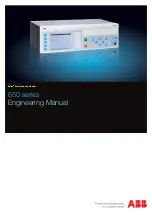Chapter 24 Cross Triggering Unit (CTU)
MPC5602P Microcontroller Reference Manual, Rev. 4
Freescale Semiconductor
621
•
A trigger event occurs during the time when the actions of the previous trigger event are not
completed (user ensures no trigger event occurs during another one is processed, but if user makes
a mistake and a trigger event occurs when another one is processed, the incoming trigger event will
be lost and an error occurs).
There are four overrun flags (one for each type of output). The general mechanism shall be as in
.
The Trigger Handler, when a trigger event occurs, and the corresponding Ready signal is high,
presents the respective trigger signal (one cycle high time + one cycle low time) to the respective
generator sub-block (ADC Command Generator, eT0 Trigger Generator, eT1 Trigger Generator or
Ext. Trigger Generator). This generator sub-block then generates the requested signal. Until this
real signal is generated (including guard time) the Ready signal is kept low.
In the case of ADC command generator, the Ready signal shall be kept low until the last conversion
in the batch is finished. The respective overrun flag is set at the following conditions:
— Ready signal is low.
— The rising edge of the respective trigger signal (from Trigger Handler to generator sub-block)
occurs.
This architecture allows the user to pre-set a trigger to the eTimer0 in the middle of an ADC
conversion, that is, the SU will be considered busy only if a request to perform the same action that
the SU is already performing occurs. One of the following bits is set: ADC_OE, T0_OE, T1_OE,
or ET_OE.
•
Invalid (unrecognized) ADC command and the ICE bit is set.
•
The MRS occurs before the enabled trigger events occur and the MRS_O bit is set.
•
TGS overrun in sequential mode: a new incoming EV occurs before than the trigger event selected
by the previous EV occurs. The incoming EV sets an internal busy flag. The outgoing trigger event
(all line are ORed) resets this flag to 0. TGS Overrun in the sequential mode shall be generated
under the following conditions:
— TGS is in sequential mode
— there is an incoming EV while the busy flag is high. the TGS_OSM bit is set.
The faults/errors flags in the CTU error flag register and in the CTU interrupt flag register can be cleared
by writing a 1 while writing a 0 has no effect. The CTU does not support a write-protection mechanism.
24.7.3
CTU interrupt/DMA requests
The CTU can perform the following interrupt/DMA requests (15 interrupt lines):
•
Error interrupt request (see
Section 24.7.2, “CTU faults and errors
) (1 interrupt line)
•
ADC command interrupt request (1 interrupt line)
•
Interrupt request on MRS occurrence (1 interrupt line)
•
Interrupt request on each trigger event occurrence (1 interrupt line for each trigger event)
•
FIFOs interrupt requests and/or DMA transfer request (1 interrupt line for each FIFO)
•
DMA transfer request on the MRS occurrence if GRE bit is set


















